
Technology firms that come up short in marketing risk falling behind their competitors and eventually becoming irrelevant. On the other hand, you can achieve impressive results and boost conversions through well-crafted tech content marketing.
How can your organization ensure it’s not wasting its content marketing budget on flawed strategies? That’s what we’re going to teach you right now.
Tech companies (both startups and incumbents) make up about 50% of our clients at Marketing Insider Group. The results they see include double-digit increases in traffic and leads.
So, we surveyed the B2B technology landscape and interviewed content marketers from brands that lead in key areas. Here, we’ll discuss their strategies and show how they approach creating content.
Buckle up and get ready to journey through the ways leading tech brands use content marketing to carve out a position in today’s increasingly competitive world. Then use the insights to upgrade your own tech content marketing strategy.
Key Takeaways:
- Buyers want great tech content full of thought leadership to guide their decisions.
- Technology brands face several challenges in creating effective tech content marketing, but they also benefit from opportunities unique to their industry.
- The best tech content has variety, visuals, and personalized elements to attract target audiences.
- While large technology companies were once reluctant to embrace content marketing, the figures show that it works.
- Understanding your audience and transitioning to a customer-centric approach is essential for success.
Why Tech Content Marketing Is Challenging But Necessary
Content marketing for tech companies presents unique challenges. First, people expect you to be at the forefront of innovation and a source of high-quality news and information.
For example, a LinkedIn report found that 78% of IT buyers need information and guidance to make decisions about their IT environment. 67% are more likely to make a purchase from a vendor who educates them at each stage of the decision process.
At the same time, tech content marketing must simplify complex, technical concepts. Interesting and engaging material must plainly explain how your product or service makes life easier to move less tech-savvy buyers into a sales call and purchase.
That’s to say nothing about the crowded marketplace and increasingly complex sales processes with multiple stakeholders. Therefore, educational, non-sales-focused content is a vital part of your overall marketing strategy that you can’t afford to neglect.
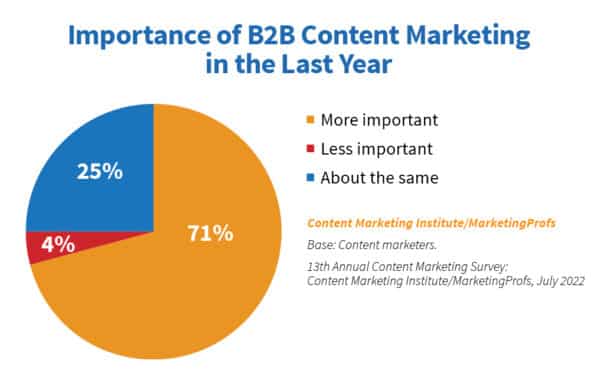
The 10 Ultimate Strategies of Content Marketing for Tech Companies
Discover the top 10 strategies the winners use for tech content marketing.
1. Write Valuable Content That Displays Thought Leadership
MarketingSherpa surveyed 4,000 B2B technology business professionals to find which types of content these buyers want most. 72% look for pieces with “solutions to solve a current problem,” and 84% expect their vendors to provide informational or educational content.
Therefore, your content needs to provide tangible benefits to your readers and not just meet SEO goals. Your goal is not just to talk about yourself. Make sure your audience walks away from an article, video, or social media post feeling educated or entertained.
Also, offer diverse perspectives and experiences from various writers and creators. The C-suite should be creating pieces but so should other members of your team, especially those who interact regularly with the customers on the front line who you want to view your content.
Keep the following points in mind to create tech content marketing that consistently delivers value:
- Write on subjects that relate to topics currently on your target audience’s mind.
- Design “evergreen” content that can provide value to a reader or viewer months or years in the future.
- Go deep into subjects with strong statistics and evidence.
- Offer actionable advice that readers can use.
- Become a go-to resource by curating the most important news items and sharing content from other thought leaders.
Also, while you’ll find subjects and topics from other sites (including competitors), you need to be original. Don’t plagiarize or rely on AI to create your content, and you can truly be a thought leader.
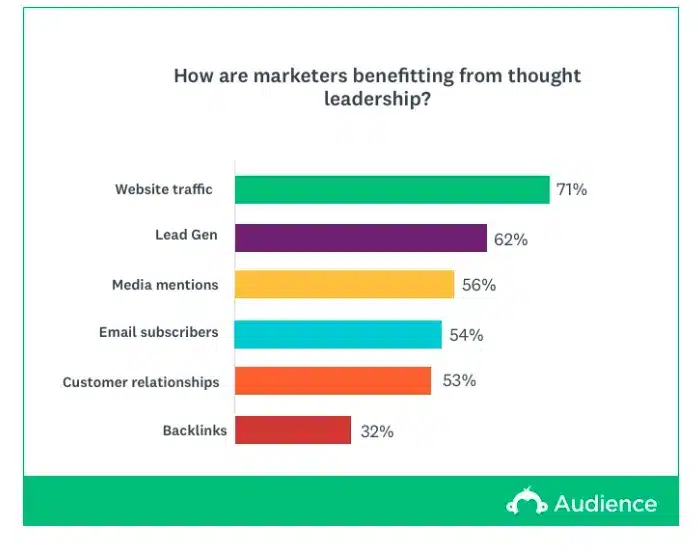
2. Tell More Stories
Even in nonfiction, great writing benefits from a “show, don’t tell” approach. That’s because the human mind loves to find a story in everything, and stories can make your abstract concept become more real.
Some of the most important stories you can tell in your tech content marketing are about customers who found success by using what you offer. Provide testimonials, case studies, and success stories for your audience.
Actually, the MarketingSherpa survey I referenced earlier found that 67% of buyers listed case studies as their most desired content. This social proof can go a long way in removing a buyer’s hesitation about working with your company.
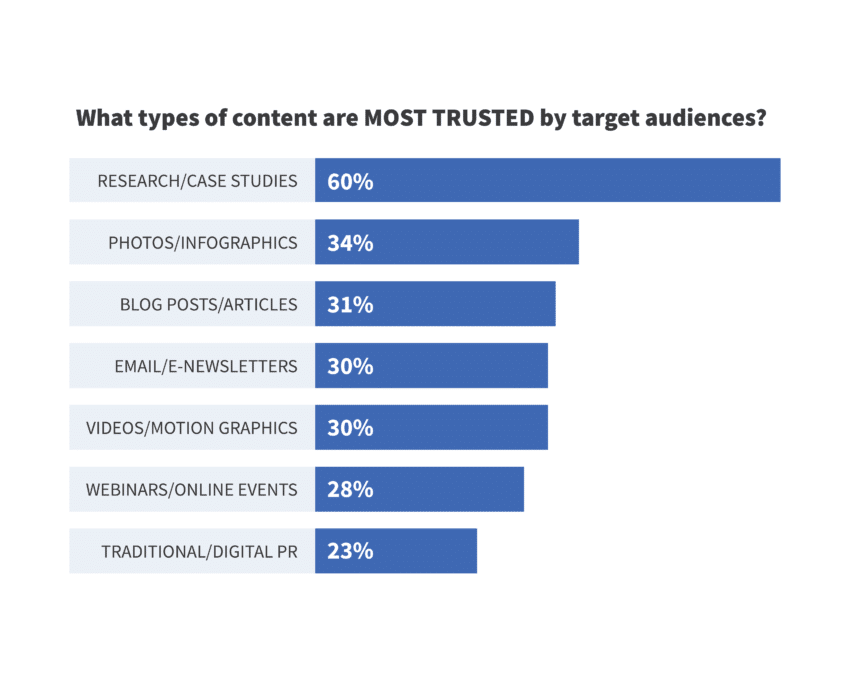
Also, use stories to explain difficult concepts. Executives and decision-makers aren’t going to be as knowledgeable as you about tech, so use comparisons and examples to make these things more understandable.
Plus, stories spark emotions, which are really what move people to action. Storytelling in your tech content marketing will encourage shoppers to become clients.
3. Be More Visual
Speaking of showing and not just telling, make sure you have sufficient images, infographics, and videos in your tech content marketing to literally illustrate your points. You’ve probably discovered that most people are visual learners, so don’t skimp on the graphics.

4. Leverage Different Types of Content
Like a popular restaurant, put variety in your tech content marketing menu. Everything doesn’t have to be a blog post.
Create animations, ebooks, white papers, and webinars. You should also leverage different perspectives by inviting guest bloggers and interviewees to share ideas, as well as making sure you post on other sites to extend your reach.
The best way to start is by updating and repurposing existing content into other formats. You’ll more quickly expand your content library and your audience.
5. Stick to a Schedule
Action and consistency are key in all parts of your business, including tech content marketing. Regular production doesn’t just expand your reach; it also helps you get better at creating content and allows you to gather valuable data that helps you discover what works.
Create a content calendar and document what you’re doing. If you need help starting or want to ensure you don’t falter, outsource your content marketing to a reputable agency, such as ours.
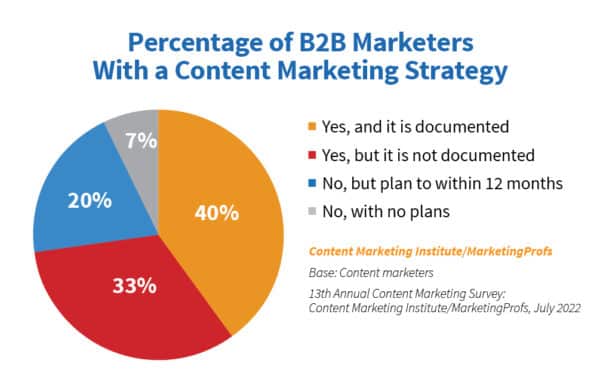
6. Use Metrics To Figure Out What’s Working
The reason why many companies continue to increase their tech content marketing budget is because it gets results. However, they deliver successful outcomes by testing their techniques, studying the data, and refining their approach.
Regularly review the results of your campaigns and test new ideas to determine what works best. If you’re working with a content marketing agency, the firm should be providing regular reports about the results of its efforts. We do that here at MIG, which is why our tech clients stick with us.
7. Personalize Your Content
Making sales is still primarily about generating positive feelings and building relationships. People more quickly forget about price when they see what you offer and think, “That’s just for me!”
Use your market research findings to segment your audience and provide them with niche material. Geo-targeting and lead magnets can help you tailor your approach.

8. Capture All Parts of the Buyer Funnel
Companies can easily fall into the trap of tech content marketing that only focuses on one type of buyer. Often, that’s writing for keywords and topics for people who already know you and what you do.
MarketingSherpa highlighted the need for customized content for each stage of the buyer funnel. Their survey found that 60% of buyers look for different types of content depending on their needs at the time.
Therefore, you must look for ways to attract folks who need your solution but don’t know what you’re about yet. Don’t forget about content for middle-stage buyers and repeat sales from existing customers, either.
(Check out how we addressed this issue at SAP in the Examples section below.)
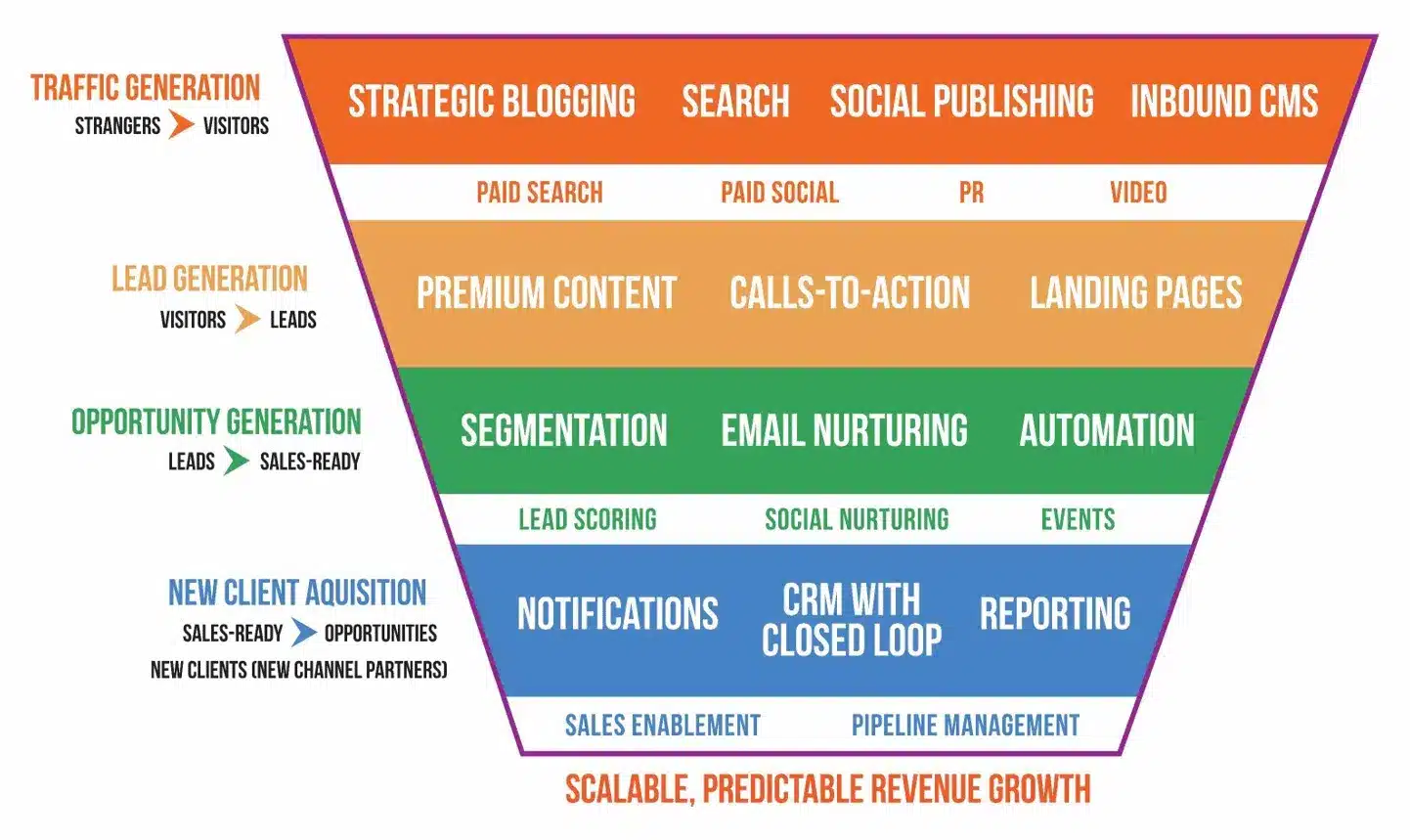
9. Maximize the Potential of Your Social Media Presence
Utilize automation and other programs to strengthen your social media presence. These platforms spur more engagement and help you build relationships through your tech content marketing.
Start by sharing your latest posts or commenting on relevant news events. You can also ask for opinions and use surveys and polls to find pain points you can design your content around.
10. Get Emails and Follow Up the Right Way
Following up is where businesses often fail in sales. Once you get contact information, keep the conversation going with email marketing. (Automation tools can help you with that, too.)
Of course, you need to find the right balance. You can’t be timid and miss out on willing customers, but you also don’t want to be pushy and get blocked.
Once again, use testing to find out the type of messages that work. For example, GetResponse’s 2023 benchmarks find that messages from RSS feeds get the best results, and triggered messages outperform regular newsletters.

Top Examples of Content Marketing for Tech Companies
Imitate the following companies if you want to master tech content marketing.
SAP
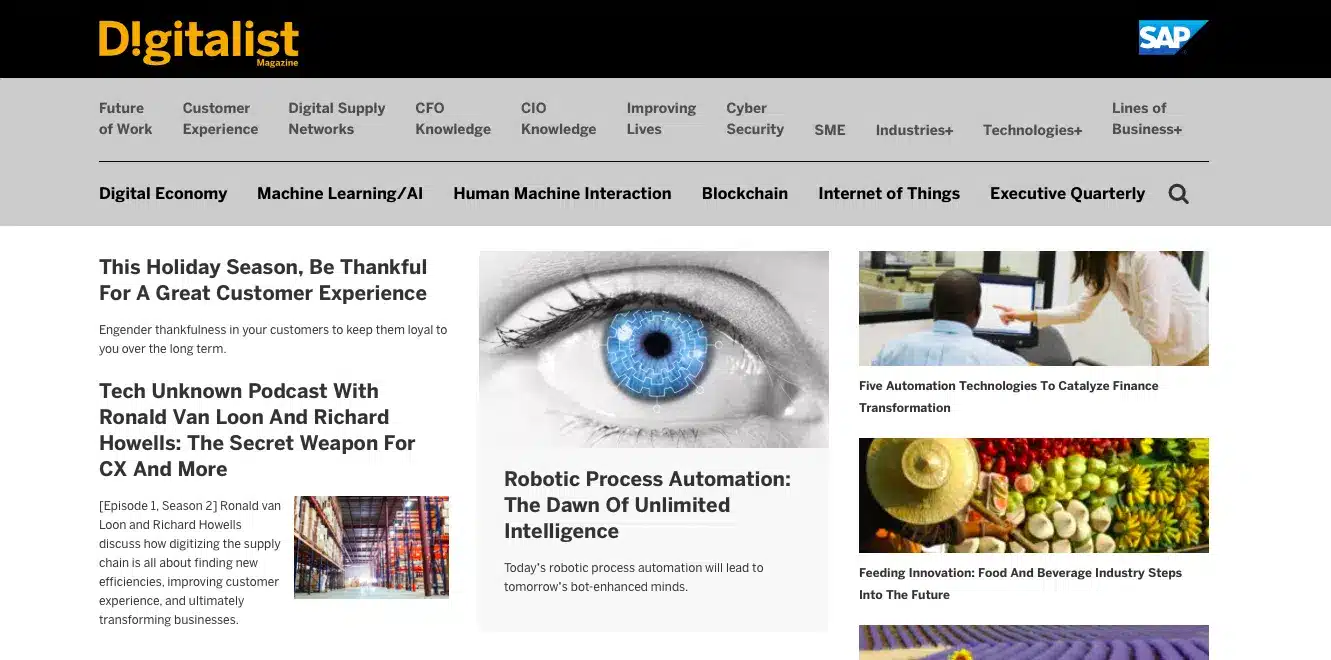
In 2011, SAP appointed me as their first Vice President of Content Marketing. In this newly created role and division, I encountered numerous challenges. Let me show you how we surmounted them.
Isolating the Challenges
SAP CEO Bill McDermott had recognized that something was missing in the company’s marketing strategy. The website was informative about their products but was missing the inspiring stories of innovation that resulted from SAP’s solutions.
The firm assigned me to fill this gap, and although the expectations were high, I started with no team and zero budget. Another problem was that some SAP marketers were resistant to the idea of tech content marketing and didn’t really understand how it would sell software.
When looking at SAP’s web analytics, I realized that no early-stage prospects were reaching the website with questions like, “What is big data?” Instead, web traffic consisted of late-stage leads that had most likely already decided to buy a SAP product.
I realized the company was missing a huge opportunity here. How could we address this need for content without any budget?
Starting With Valuable Thought Leadership Content
After discovering most of the previous years’ advertising campaigns were hemorrhaging money and not converting, I struck a deal with the head of advertising. I’d use half their landing page budget to create a tech content marketing platform that also served as a sales landing page.
The result was Digitalist. This online magazine used the power of compelling content and storytelling to drive conversions.
By the end of the first year, our content marketing efforts had generated almost 1,000 leads and converted into approximately $750,000 in revenue. This translated to a 7X ROI based on our first-year expenses of $100,000.
(In fact, this content initiative was the highest ROI of any program at SAP that year.)
To this day, Digitalist continues to engage customers and drive sales for SAP by publishing valuable content about the future of work, customer experience, and up-and-coming technologies.
Of course, we didn’t stop there.
Setting Goals and Using Research To Improve
In 2012, SAP began a marketing initiative that put content at the forefront with the SAP Business Innovation blog. The site’s goals were to:
- Create an affinity for SAP products
- Establish the brand as a thought leader by answering early-stage buyer questions
- Drive calls to action
To formulate the strategy, the team began with a tech content marketing audit to find differences in organic search traffic. We compared the results between unbranded terms (like “big data”) versus SAP’s branded terms that included product names (like “HANA”).
The team found there were many more search queries across nearly every one of the categories for unbranded search terms. They then looked at how much traffic SAP received from these non-branded searches and uncovered that 99.9% of SAP’s traffic came from branded search terms.
This meant almost all traffic was from late-stage prospects already considering purchasing from SAP. Virtually none of their traffic was from early-stage prospects looking for potential solutions.
This was a big problem because SAP was vastly expanding its portfolio. The goal was to include new solutions to grow awareness and penetrate additional markets.
The final step was to look at the existing catalog of their content by buyer stage. They found that 94% of their tech content marketing was for middle-stage or late-stage buyers, which mirrored the type of traffic they were receiving but not the traffic they wanted.
Capturing All Parts of the Funnel
Based on this data, the team knew they needed to focus on reaching early-stage buyers, especially in these newer solution categories. As a result, we redirected the focus of the blog.
Today, Business Innovation “helps executives develop a deeper understanding of the trends affecting the future of business through fact-based executive research, supplemented by the latest thinking from expert bloggers”. The site’s over 11,000 blog posts are easy to navigate with categories including Future of Business, Technologies, Line of Business, Industries, and SMB.
SAP also customizes its tech content marketing for every buyer, no matter where they are in their journey with:
- Early-stage content: Quality, licensed content around broader, shareable topics that drives visibility and engagement through blog posts
- Middle-stage content: A combination of licensed and original content that hits on niche topics specific to SAP’s offerings and solutions, such as white papers, case studies, videos, and infographics
- Late-stage content: Original content promoting SAP’s products and services through technology guides and case studies
- Customer-stage content: Consistent cadence and mix of content as well as personalized recommendations in white papers, case studies, and technology guides
The fresh strategy proved to be and continues to be a success with leaps in traffic, engagement, and publicity. Within a year of the new launch, the site:
- Received 3 million page views
- Averaged 5 minutes in time-on-site engagement
- Converted 1,800 prospects
- Received recognition from notable publications, including Fast Company, Content Marketing Institute, and Digiday
As you can see, a complete tech content marketing strategy leads to unquestioned success.
IBM

Many consider IBM to be one of the world’s most successful brands in tech content marketing. In fact, it has carried out hundreds of successful content campaigns that it directed at markets ranging from individual consumers to global corporations.
IBM publishes and manages several blogs to target different audiences:
- THINK harnesses the power of storytelling to provide insights into how disruptive technologies are changing our world for the better.
- IT Infrastructure explores how new technologies and opportunities such as big data and analytics, hybrid cloud, and AI are changing IT infrastructure to provide insights and inspiration for IT leaders.
- The Internet of Things blog focuses on IoT technologies and their use in buildings, asset management, aerospace, automotive, health, and other industries.
- Watson covers case studies and stories about how companies have used Watson, IBM’s suite of AI tools and services for enterprises
- IBM’s IT Services blog covers information about the business side of using technology, such as talent acquisition, data protection, automation, and customer analytics.
IBM also has a popular YouTube channel, which it uses to publish high-quality video content that does a great job of explaining complex topics in a simple way. For example, check out this breakdown of how the Watson Assistant works.
Video Embed: Behind the Algorithm – IBM Watson Assistant Explained
The team at IBM are experts at understanding their audience and delivering targeted tech content marketing to educate, inspire, and communicate with current and potential customers. IBM also showcases the power of its own solutions, such as using Watson to power its own brand websites.
IBM has seen a huge payoff from all of these efforts. Industry leaders recognize its team as world-class marketers, and their content has driven millions of impressions to IBM’s website, engaged millions of customers on social media, and generated millions of dollars in revenue.
Cisco
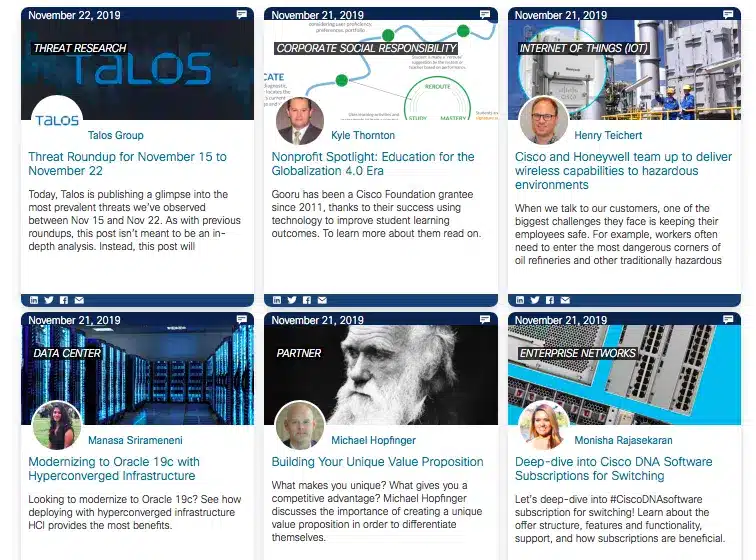
Networking conglomerate Cisco has openly embraced tech content marketing from the beginning. In 2015, the brand announced plans to hire over 200 content marketers as part of its effort to refocus its marketing strategy around content.
However, one of Cisco’s most famous content marketing successes dates way back to 2008. At that time, it decided to run an experiment by launching its new router across its three main social media channels (Facebook, Twitter, and YouTube) instead of following its standard product launch template.
The launch was a major success; in fact, it became one of the company’s top five launches ever. Even better, the campaign only cost a fraction of its usual $100,000 product launch budget.
Cisco understood from an early stage that to see real success in tech content marketing going forward it would need to take the focus away from products and take a customer-centric approach. By segmenting its customers into audience personas and combining creative content with marketing technology, it was able to deliver highly personalized and valuable content.
A study of a single Cisco content campaign showed that the company achieved 72% of its engagement goals in just a couple of months. Plus, the campaign drove 34,000 partner activations and 300 million social impressions.
Cisco is a great example of how B2B content marketing doesn’t have to be boring. By using the same features as easy-to-understand, engaging, and interesting B2C content, they’ve demonstrated that B2B tech content marketing can be fun, innovative, and successful.
RJMetrics
Content marketing helped fuel RJMetrics’ rise to the point that Magento saw fit to purchase the young company. In particular, data storytelling was key to the firm’s success.
The analytics company developed several viral content hits by rolling up its sleeves and digging into data to tell a compelling story. For example, it created the engaging Ecommerce Growth Benchmark report.
As RJ’s former director of marketing Janessa Lantz told Scribewise, the company focused on creating and distributing high-quality pieces that would have an impact. “We ask ourselves what the industry is dying to know about, or whether or not someone would pay $150 for this research or blog post,” Lantz said.
Curalate
Curalate blew up rapidly and attracted top retailers as clients, including Nordstrom, Neiman Marcus, and Sephora, to its visual commerce platform. When Brendan Lowry started the company’s content initiative, he brought on former journalist Jared Shelly to manage its tech content marketing.
Shelly mentioned four main goals the company tries to accomplish:
- Increasing brand awareness
- Bringing new leads into the sales funnel
- Establishing thought leadership
- Helping to attract talent
As with all successful content marketing initiatives, the focus is not simply on what Curalate sells. Rather, its content concentrates on what its customers are looking for — information that helps them do their job.
“People seem to really enjoy UNFILTERED,” said Shelly. “[It’s] a series where we interview Instagram influencers and dynamic marketers like Eric Toda of Airbnb or Nina Alexander-Hurst from Baublebar.”
Speaking of Curalate, one of its investors was First Round Capital, another tech content marketing superstar.
First Round Capital
If you’re a tech entrepreneur, First Round Review is a must-read. When former Wall Street Journal reporter Camille Ricketts took over the blog, she instituted the goal of taking information out of the brains of tech biz experts and turning it into actionable insights for founders and aspiring founders.
As a result, First Round has accumulated a massive audience. Its tech content marketing has earned more than 215,000 followers on X and 117,000 LinkedIn followers.

Salesforce
In 1999, Salesforce began as a CRM company. Since then, the brand has grown into a tech giant, expanding its end-to-end SaaS offering. From the beginning, however, sharing customer success has been at the forefront of its marketing strategy.
Salesforce’s Customer Success Stories page is the core hub for sharing these accounts and case studies with prospects and customers. Readers can filter through the comprehensive collection by industry, product, or business size to find the best match for their use case.
The brand’s collection of case studies not only covers vast depth and breadth, but the content itself is also compelling and comprehensive. Each case study is complete with a detailed use case, screenshots of the customer’s customized Salesforce instance, a list of all Salesforce products the customer uses, and a customer quote.
Salesforce also amplifies some case studies with a high-quality video of the customer narrating his or her story. While powering this extensive tech content marketing catalog is no easy task, the team has developed a “content engine” system that starts with a central focus.
Senior Director of Digital & Design, Amanda Nelson, explained to the Content Marketing Institute: “We start with an ebook. From there, we publish the content by recycling and reusing it on multiple media.
- We’ll read the ebook aloud and make it an audiobook.
- We’ll interview the customer for a quote in the ebook and then put that up as a video.
- We’ll take the audio from the video and make a podcast.
- We’ll create a presentation from the ebook with highlights.”
A team of dedicated marketers with various roles and responsibilities powers this tech content marketing strategy. The group covers everything from writing the content to distributing and optimizing it on social to designing visuals that bring the content to life.
As a result, the team generated about a 300% year-over-year increase in ebook shares and downloads. They also reported a 150% increase in blog post social shares.
Zuora
Zuora is a cloud-based software company that provides everything needed to run a subscription-based business. Essentially, the brand is selling a business model and aiding the transition from selling a product outright to a subscription instead.
To support this mission, Zuora founded its Academy, a central source filled with straightforward and actionable advice. The Academy includes informative content, ranging from foundational overviews to industry deep-dives, for a variety of roles including marketing, finance, technology, and operations.
Zuora’s Editor-in-Chief, Gabe Weisert, explains: “The goal is to teach people, and we definitely try to do that in the most entertaining, compelling way possible.”
Customer success managers and finance decision-makers are Zuora’s main target audiences. Therefore, its tech content marketing focuses on those organizations’ pain points (such as retaining customers, fighting churn, and billing) rather than Zuora’s product offerings.
To create the content, the team interviews a variety of resources, including Zuora customers and finance and marketing professionals. Weisert explains further: “Everyone loves to talk; nobody likes to write. A lot of times we’ll hold 30-minute interviews, record the transcript, and edit that down so we still get a sense of the person’s personality.”
Lead generation is also a key performance indicator at the center of Zuora’s strategy. The team successfully approaches this by un-gating all of its copy but gating the option to download PDF versions.
With this tech content marketing strategy, anyone can easily access Zuora’s helpful content. However, Zuora only captures the contact information for prospects with strong interest.
Finally, while creating quality content is the backbone of the Academy’s strategy, the team has noticed common trends within its best-performing pieces. Then, it capitalizes on those trends.
Weisert shares: “Titles are super important, [as are] odd numbers, how-tos, talking about things that didn’t go well, mistakes to avoid, etc. These are all things that consistently perform for us.”
Shopkeep
Founded in 2008, ShopKeep is a cloud-based mobile point-of-sale solution for small and medium-sized businesses. The company’s mission has always been to help local brick-and-mortar businesses succeed, and a big part of that means useful content.
In 2013, the company launched Counter Culture, a news and advice center that focused on helping small businesses succeed. Formulating the tech content marketing strategy took about two months, and the team went straight to the source to find out what their audience wanted.
Paul Nugent, ShopKeep’s Director of Content explains: “We interviewed merchants, did site visits, and hosted phone calls with small business owners. We asked about their pain points and areas of concern.”
Shopkeep organizes content by important topics universally relevant to small businesses, including inspiration, money, operations, planning, and technology. ShopKeep also leverages the expertise of other small business owners as guest bloggers, using Counter Culture as a platform for knowledge exchange.
Nugent adds: “Small business owners don’t always want to hear what we have to say. They want to hear what other small business owners have to say and their point of view.”
To drive consistent engagement, Counter Culture’s distribution strategy includes a weekly digest for its subscribed readers. Staying true to keeping its readers as the focus, however, the digest doesn’t only include Counter Culture content.
Instead, the weekly digest includes anything the team sees around the web that week that they feel is valuable for their audience, regardless of the source. Over time, this tech content marketing strategy has evolved to include prioritizing SEO and including middle and bottom-of-the-funnel content.
For example, the team started writing more helpful content around point-of-sale topics, such as how to run employee shift reports. These efforts helped Counter Culture rank on SERPs when a potential prospect is organically searching for that information.
Need Help With Your Tech Content Marketing?
These strategies and examples are great, but you might need help to put them into practice. MIG is more than ready to be your guide.
If you‘re ready to get more traffic to your site with quality content, check out our Content Builder Service. Get started today and generate more traffic and leads for your business with the best tech content marketing out there.
0 Commentaires